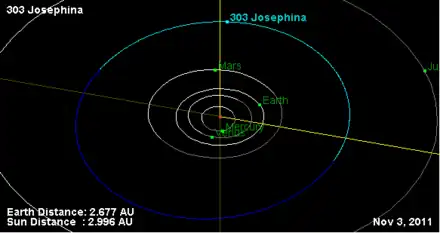| Discovery | |
|---|---|
| Discovered by | Elia Millosevich |
| Discovery date | 12 February 1891 |
| Designations | |
| (303) Josephina | |
| A891 CA; 1948 MA 1974 KC | |
| Main belt | |
| Orbital characteristics[1] | |
| Epoch 31 July 2016 (JD 2457600.5) | |
| Uncertainty parameter 0 | |
| Observation arc | 124.85 yr (45600 d) |
| Aphelion | 3.31643 AU (496.131 Gm) |
| Perihelion | 2.92967 AU (438.272 Gm) |
| 3.12305 AU (467.202 Gm) | |
| Eccentricity | 0.061920 |
| 5.52 yr (2015.9 d) | |
| 357.173° | |
| 0° 10m 42.892s / day | |
| Inclination | 6.87269° |
| 344.002° | |
| 64.1014° | |
| Physical characteristics | |
| Dimensions | 99.29±1.9 km |
| 12.497 h (0.5207 d) | |
| 0.0594±0.002 | |
| Temperature | unknown |
| 8.9 | |
Josephina (minor planet designation: 303 Josephina) is a large Main belt asteroid.[1] It was discovered by Elia Millosevich on 12 February 1891 in Rome. It was first of his two asteroid discoveries. The other was 306 Unitas.
- Orbit diagram

References
- 1 2 "303 Josephina". JPL Small-Body Database. NASA/Jet Propulsion Laboratory. Archived from the original on 15 September 2020. Retrieved 11 May 2016.
External links
- 303 Josephina at AstDyS-2, Asteroids—Dynamic Site
- 303 Josephina at the JPL Small-Body Database
This article is issued from Wikipedia. The text is licensed under Creative Commons - Attribution - Sharealike. Additional terms may apply for the media files.